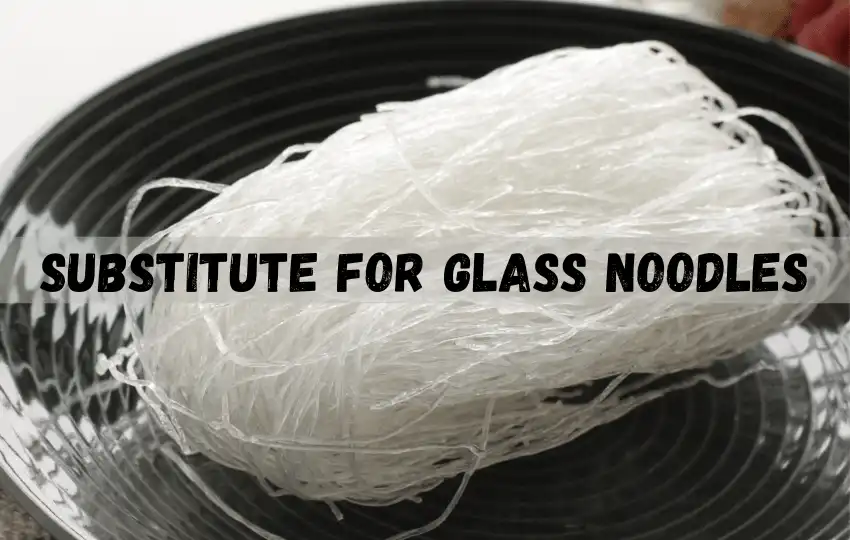Glass noodles are a staple in Asian cuisine, commonly used in stir-fries, soups, and salads.
However, suppose you’re looking for a substitute for glass noodles due to dietary restrictions, pantry shortages or something else. In that case, plenty of alternatives can easily replace them.
In this blog post, I’ve compiled a list of the top 11 substitutes for glass noodles, complete with ratios and instructions on how to use them.
These substitutes will impress your tastebuds and come in handy next time you’re in a pinch.
In short, " What can I use instead of glass noodles?" Rice Noodles, Soba Noodles, Bean Thread Noodles, Shirataki Noodles, Spaghetti Squash, Zucchini Noodles, Sweet Potato Noodles, Spaghetti, Udon Noodles, Ramen Noodles, and Egg Noodles.
What are glass noodles, and what do glass noodles taste like?
Glass noodles, also called cellophane noodles or bean thread noodles, are transparent noodles made from starch, typically mung bean or sometimes other ingredients like potato or tapioca starch.
They are popular in various Asian cuisines, including Chinese, Korean, and Thai.
In terms of taste, glass noodles are relatively mild and have a neutral flavor. They do not have a strong taste of their own, allowing them to absorb the flavors of the ingredients they are cooked with.
The texture of glass noodles is unique, as they become soft and slippery when cooked, resembling a slightly chewy and gelatinous consistency.
They add a pleasant textural element to the dish and serve as a vehicle for the flavors of the accompanying ingredients.
They are usually praised for their ability to take on the flavors of sauces, seasonings, and other ingredients, making them a popular choice in many Asian dishes.
Overall, glass noodles are prized for their light and delicate nature, providing a satisfying mouthfeel while allowing the dish’s flavors to shine.
Uses of glass noodles
Glass noodles are an incredibly versatile ingredient in many Asian dishes. Due to their unique texture and low-calorie content, they are popularly used in stir-fries, salads, soups and spring rolls.
When preparing glass noodles for cooking, it is important to soak them first before adding them to a dish.
This helps soften the noodles, which makes them more palatable and easier to digest.
After soaking, the glass noodles can be sautéed with vegetables such as carrots and peppers for a quick stir fry or added to soup broth for a comforting noodle soup.
They can also be combined with other proteins like chicken or beef for added flavor.
For something different, glass noodles can be tossed with sesame oil or soy sauce along with vegetables for a tasty salad option that’s high in fiber and low in calories.
In addition, they make great wraps for homemade spring rolls; simply soak the noodles until soft, then fill them with your favorite crunchy vegetables or meat before rolling them up into bite-sized parcels.
Where to buy glass noodles?
If you are looking for glass noodles where to buy, there are a few other places you can go. Many specialty food stores carry it, as do some international grocery stores.
You can also order online from many retailers that provide a variety of diverse flavors and types of glass noodles.
Best substitutes for glass noodles with measurement
1. Rice Noodles – A good substitute for glass noodles
One of the most generally used substitutes for glass noodles is rice noodles, also known as vermicelli noodles.
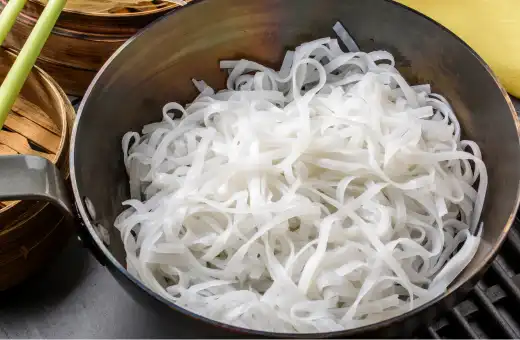
They have a similar texture and thickness to glass noodles and are often used interchangeably in many dishes.
Ratio or measurement: To replace glass noodles with rice noodles, use a 1:1 ratio, meaning if the recipe needs one cup of glass noodles, use one cup of soaked rice noodles instead.
2. Soba Noodles – similar to glass noodles
Soba noodles are produced from buckwheat flour and have a nutty savor and a slightly chewy texture.
Ratio or measurement: If you're looking to replace glass noodles with soba noodles, use a 1:1 ratio.
However, keep in mind that soba noodles tend to be thicker than glass noodles, so you may require to adjust the cooking time accordingly.
3. You can try Bean Thread Noodles to replace glass noodles
Bean thread noodles, or cellophane or glass noodles, are created from mung bean starch and are a common alternative to glass noodles.
They have a similar texture and translucent appearance, so they work well as an alternative in many dishes.
Ratio or measurement: To replace one cup of glass noodles with bean thread noodles, use one cup of soaked bean thread noodles.
4. Shirataki Noodles – similar to glass noodles
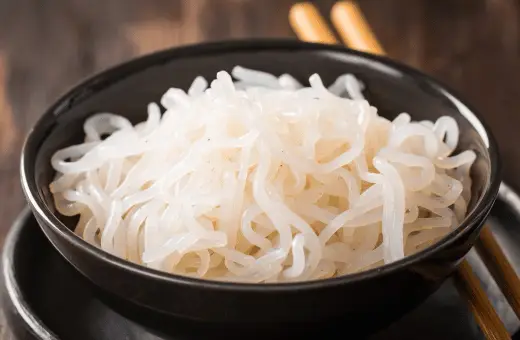
Shirataki noodles are created from konjac yam and are lower in calories and carbohydrates, making them a famous choice for those who are watching their diet.
They have a neutral taste and a slightly chewy texture.
Ratio or measurement: To replace glass noodles with shirataki noodles, use a 1:1 ratio and rinse them well before using them.
5. Spaghetti Squash – a tasty alternative for glass noodles
If you’re searching for a low-carb alternative to glass noodles, spaghetti squash is an excellent option.
The flesh of the spaghetti squash separates into spaghetti-like strings that can be used as a substitute in many dishes when cooked.
Ratio or measurement: To replace one cup of glass noodles with spaghetti squash, use around two cups of cooked spaghetti squash.
6. Zucchini Noodles – similar to glass noodles
Zucchini noodles, also known as zoodles, are a popular low-carb alternative to pasta and can also use as a substitute for glass noodles.
They’re easy to prepare and have a slightly crunchy texture.
Ratio or measurement: To replace one cup of glass noodles with zucchini noodles, use around two cups of spiralized zucchini.
7. Use Sweet Potato Noodles instead of glass noodles

Sweet potato noodles, or glass noodles, are made from sweet potato starch and are a popular ingredient in Korean cuisine.
They have a similar texture and translucent appearance to glass noodles and can be used interchangeably in many dishes.
Ratio or measurement: To replace one cup of glass noodles with sweet potato noodles, use one cup of soaked sweet potato noodles.
8. Spaghetti – similar to glass noodles
Yes, you read that right! Spaghetti can be a great substitute for glass noodles.
Ratio or measurement: For every pound of glass noodles, use 1 pound of spaghetti.
Boil until al dente and use in stir-fries, soups, or even as a base for a spaghetti salad.
9. Udon Noodles – a decent replacement for glass noodles
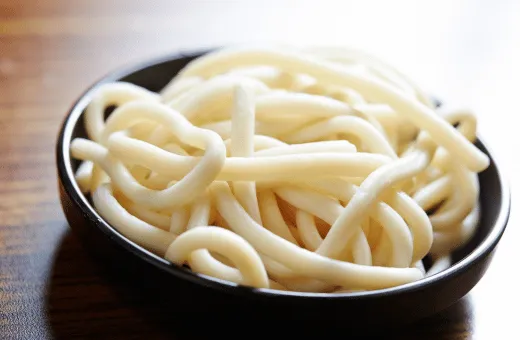
Ratio or measurement: For every pound of glass noodles, use 1 pound of udon noodles.
Cook according to package instructions and use in soups or stir-fries.
10. Ramen Noodles – similar to glass noodles
Ratio or measurement: For every pound of glass noodles, use 1 pound of ramen noodles.
Cook according to package instructions and use in stir-fries or as a base for a ramen noodle soup.
11. Egg Noodles – An ideal substitute for glass noodles
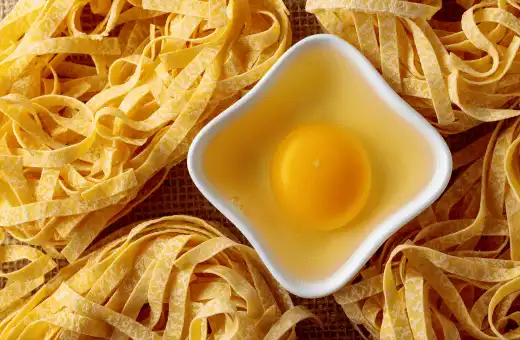
Ratio or measurement: For every pound of glass noodles, use 1 pound of egg noodles.
Boil until al dente and use in stir-fries or in a warm noodle soup.
How to Choose the Most Suitable Substitution Option for glass noodles
When choosing a substitution option for glass noodles, consider the following tips:
1. Texture: Glass noodles have a unique, soft, and slippery texture when cooked. Look for alternatives that can provide a similar texture.
Options like rice vermicelli or rice noodles can be suitable substitutes, as they offer a similar thin and delicate texture.
2. Flavor Absorption: Glass noodles are known for their ability to absorb flavors from sauces and other ingredients. Choose a substitution option that can effectively absorb the flavors of the dish.
Rice vermicelli or rice noodles can absorb sauces and seasonings well, making them a good choice.
3. Cuisine Compatibility: Consider the cuisine you’re preparing and choose a substitution option that aligns with the flavors and ingredients of that cuisine.
For example, if you’re making a Thai dish, rice noodles would be a suitable choice, while soba noodles might work well in a Japanese-inspired dish.
4. Cooking Time: Different types of noodles may have varying cooking times. Consider the cooking time of the substitute option and adjust accordingly to ensure they are cooked to the desired texture.
5. Allergies and Dietary Restrictions: Take into account any dietary restrictions or allergies when selecting a substitute.
Glass noodles are typically gluten-free, so if you need a gluten-free option, look for rice noodles or other gluten-free noodle alternatives.
6. Experiment and Adjust: Conduct taste tests and experiments with different substitute options to determine which one best suits your preferences and the specific requirements of the dish.
Consider factors such as taste, texture, and how well the substitute complements the other ingredients.
Conclusion on substitute for glass noodles
Overall, there are plenty of excellent substitutes for glass noodles, and it’s easy to adjust the ratios accordingly.
Whether you opt for rice noodles, soba noodles, bean thread noodles, shirataki noodles, spaghetti squash, zucchini noodles, or sweet potato noodles, these alternatives will provide a similar texture and flavor to your dishes.
So next time you see yourself without a box of glass noodles, don’t hesitate to use one of these substitutes instead.
FAQs on substitute for glass noodles
Q1. What is similar to glass noodles
Cellophane noodles, also known as glass or bean thread noodles, are a variety of transparent noodles made from starch and water. These thin strands have a unique texture that is similar to glass noodles.
They are most commonly made from mung bean starch but can also be made with potato, arrowroot, sweet potato, or tapioca starch.
Cellophane noodles are often used in Asian cuisines, such as soups and stir-fries. Their versatility makes them a popular ingredient in many different recipes because they can easily absorb the flavor of the broth or sauce they are cooked in.
Additionally, cellophane noodles cook quickly and do not require pre-soaking like other types of noodles.
Q2. Can I use rice noodles instead of glass noodles?
Yes, you can utilize rice noodles instead of glass noodles. Rice noodles are a kind of pasta made from rice flour and water.
They have a light flavor and tender texture, which makes them ideal for stir-fries, salads, soups, and other types of dishes.
Additionally, they are gluten-free and lower in fat, making them healthier than multiple other types of pasta. They cook quickly, too, meaning you won’t have to spend hours preparing your meal in the kitchen.
Q3. Are glass noodles and rice noodles the same?
No, glass noodles and rice noodles are not the same. Glass noodles, also known as cellophane noodles or bean thread noodles, are made from mung beans and have a translucent appearance.
On the other hand, rice noodles are usually made of either white or brown rice flour and water. Rice noodles are much thicker than glass noodles, and their texture is more chewy.
In terms of flavor, glass noodles tend to be neutral in taste, while rice noodles have some sweetness due to the presence of sugar in the dough.
Furthermore, glass noodles contain more fiber than rice noodles, with about 3g per serving compared to just 0.5g for the latter.
Another key difference is that glass noodles require soaking before cooking, whereas rice noodles do not need to be soaked before use.
Additionally, the two types of noodles can be used in different dishes – glass noodles are often used in stir-fries and salads, while rice noodle dishes usually feature soups or noodle bowls.
Q4. What can I use instead of glass noodles in japchae?
Instead of glass noodles, you can use sweet potato starch noodles, also known as Korean dang myun. These chewy, thin noodles are a classic and versatile option for japchae recipes.
Made from sweet potatoes that have been cooked till they turn into a paste and then pressed through a sieve to make the noodles, these sticky strands add texture and flavor to any dish.
They’re also gluten-free and contain no artificial colors or preservatives, making them ideal for anyone looking to lighten up their japchae dish.
Sweet potato starch noodles are readily available in most Asian grocery stores or online retailers. To cook them, simply boil a pot of water and add the noodles.
Simmer for 8–10 minutes before straining and rinsing with cold water—this helps prevent them from sticking together when added to the japchae ingredients.
Q5. Is vermicelli the same as glass noodles?
No, vermicelli and glass noodles are not the same.
Vermicelli is a kind of pasta made from durum wheat that is thin and round in shape, while glass noodles (also known as cellophane or bean thread noodles) are created of mung bean starch and have a translucent appearance.
Glass noodles tend to be more delicate than pasta, with a smoother texture and almost jelly-like consistency when cooked. They also require less time to cook compared to vermicelli.
As such, they are often used in dishes such as stir fries and salads, where their unique texture enhances the overall flavor.
In contrast, vermicelli can be used in various dishes, from soups, salads to casseroles and stir-fries. It also has a firmer texture that holds up well against stronger flavors.
Overall, both noodles offer different textures and flavors, so it is essential to believe which one best suits your particular dish.

